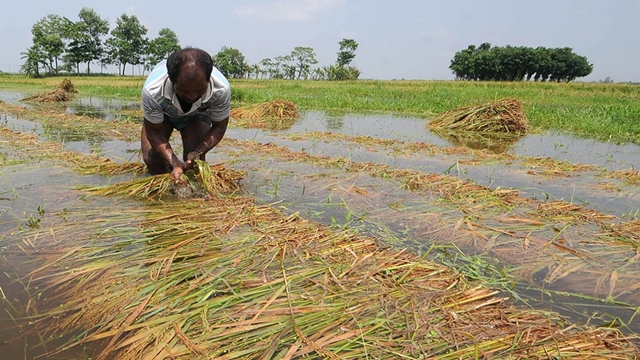FT Online
Published:2019-07-29 21:00:39 BdST
Floods play havoc with Aman farming
Floodwaters have continued to recede across the country for the past three days, but inundation has yet dealt Aman farming a severe blow in 25 districts.
Seedbed damage, delay in plantation and seedling shortages might disrupt Aman cultivation in the areas, resulting in a poor yield, insiders said.
Aman contributed 38 per cent to the total rice production in the country.
According to the department of agriculture extension (DAE), more than 0.45-million hectare farmlands have been submerged in the three-week floods.
Above 0.15 million hectares of land with Aus paddy, Aman seedbeds, vegetables and other crops witnessed 40-100 per cent damage in the deluge.
Floods have devastated 22,000-hectare Aman seedbeds, positing seedling shortages for farmers who will not get time to make seedbeds again after waters retreat from farmlands and homesteads, said insiders.
"It's peak time for farmers to grow Aman seedlings," said Bangladesh Krishak Samity president SMA Sobur.
"Instead, they are busy saving their own lives in Nilphamari, Rangpur, Lalmonirhat, Gaibandha, Kurigram, Bogura, Sirajganj, Jamalpur, Netrakona, Sunamganj and Sylhet districts."
Mr Sobur said most of the farmers lost their Aman seedbeds in Kurigram, Gaibandha and Jamalpur districts.
Floodwaters might ebb from farmlands in the inundated districts fully in the next two weeks if good climatic conditions persist, he added.
"This would create a shortage of seedlings and many will be forced to delay their plantation, suggesting a low production," observed the farmers' rights activist.
He said the flood-ravaged districts usually contribute more than 42 per cent to the national rice production.
DAE director (field service wing) Dr Md Abdul Muyeed said crop loss due to floods is minor as farmers were just preparing for Aman cultivation.
Although plantation could be continued till mid-September, further rain and onrush of upstream water might cause disruptions to Aman farming, he added.
Mr Muyeed said DAE has started growing seedlings in highlands of the flooded districts to help farmers and affected farmers would also get fertiliser for free.
DAE officials, however, said they have targeted to produce 15 million tonnes of rice from 5.6 million hectares of land this Aman season.
It was 14.3 million tonnes in the last fiscal year, according to DAE.
Bangladesh Institute of Development Studies researcher Iqbal Hossain said flooding during Aman farming is a common phenomenon in the Bengal delta.
The trouble arose after introduction of high-yielding varieties (HYVs) in Aman season to boost production replacing traditional varieties like Panishail, Chamara, Hijoldigha and Agune, which could fight inundation, he added.
Mr Hossain said, "It's not possible to return to the 1980s as we need maximum output from minimum lands."
"But organisations like Bangladesh Rice Research Institute and Bangladesh Institute of Nuclear Agriculture should develop flood-prone varieties to coup with random floods," he cited.
Meanwhile, flood forecasting and warning centre in its Sunday evening update said all major rivers might recede except the Kushiyara and others in south in the next 24 hours.
Flood situation all over might improve the next day.
But the Met office forecast heavy rainfall in the south-eastern and south-central parts in the next 24 hours amid ongoing depression in the Bay of Bengal.
Meanwhile, health emergency operation centre and control room under health directorate reported on Sunday 119 deaths in the floods by drowning, snakebite and lightning as major reasons.
Unauthorized use or reproduction of The Finance Today content for commercial purposes is strictly prohibited.


